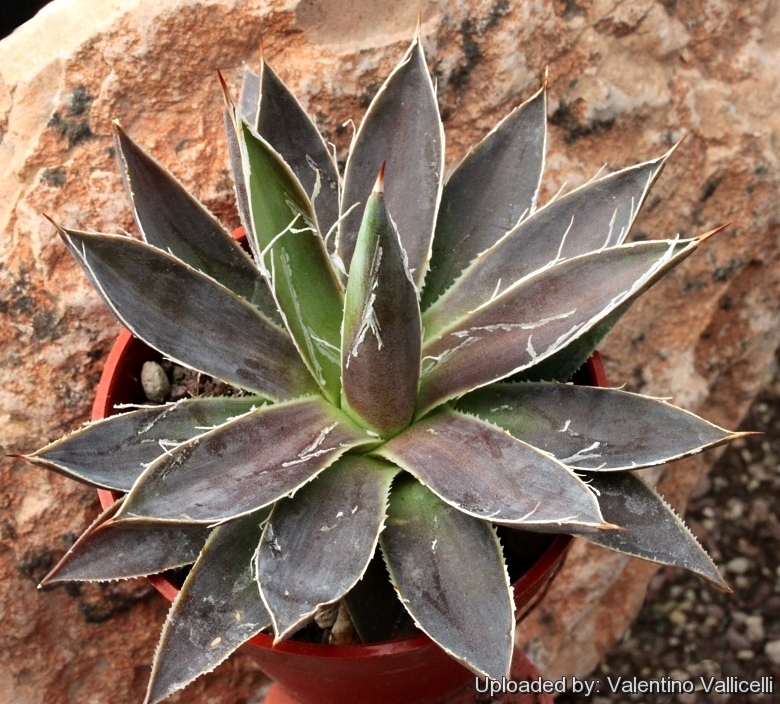
Agave filifera subs. schidigera f. compacta Photo by: Valentino Vallicelli
(Dwarf compact form) The small size, very decorative symmetrical leaves and toothless nature combine to make this a very desirable plant for container growing. It is one of the prettiest and most sought after Agaves. It is decorated with thin white curly marginal fibres spreading in all directions and with very ornamental white bud imprints. These imprints vary in tone and become more noticeable with age.
Origin and Habitat: Garden origin (Nursery produced cultivar)
Synonyms:
See all synonyms of Agave filifera
Common Names include:
ENGLISH: Agave Durango Delight, Agave Shidigera Compact
Description: Agave schidigeraSN|556]]SN|556]] "compacta" is a very compact, small, symmetrical plant, growing to 20-30 cm wide and 20-25 cm tall. Plants that are five to ten years old consist of 100-150 leaves which radiate uniformly from the centre, giving the plants a very symmetrical shape.
Leaves: The dark green 10 to 15cm long and 2,5 cm wide at their widest point. They are decorated with thin white curly marginal fibres spreading in all directions which sometimes are very dense. There are no marginal teeth on the leaves; however, the tip is very sharp and can inflict some damage. The leaves which vary in colour (on the same plant) from dark green to a bronzish-green colour have very ornamental white bud imprints. These imprints vary in tone and become more noticeable with age.
Flower: The flower stalk is up to 3 m tall and is densely loaded with yellowish-green to dark purple flowers up to 5 cm long.
Blooming Season: Late Spring through Early Summer. It blooms only every 30 to 40 years and die after flowering, but new plants may develop from suckers at its base.
More...Subspecies, varieties, forms and cultivars of plants belonging to the Agave filifera group
 Agave filifera Salm-Dyck: Forms tight rosettes of narrow, hairy, stiff dull-green leaves with very sharp terminal spines.
Agave filifera Salm-Dyck: Forms tight rosettes of narrow, hairy, stiff dull-green leaves with very sharp terminal spines. Agave filifera f. cristata: This is one the very few known crested agaves, it forms a strange fan shaped, wavy rosette.
Agave filifera f. cristata: This is one the very few known crested agaves, it forms a strange fan shaped, wavy rosette. Agave filifera subs. schidigera (Lem.) B.Ullrich: Small or medium sized plant that forms stemless rosette to 60 to 90. It is decorated with thin white curly marginal fibres spreading in all directions which sometimes are very dense.
Agave filifera subs. schidigera (Lem.) B.Ullrich: Small or medium sized plant that forms stemless rosette to 60 to 90. It is decorated with thin white curly marginal fibres spreading in all directions which sometimes are very dense. Agave filifera subs. schidigera f. compacta hort.: Very compact, small, symmetrical plant, growing to 20-30 cm wide and 20-25 cm tall. Leaves decorated with thin white curly marginal fibres and with very ornamental white bud imprints.
Agave filifera subs. schidigera f. compacta hort.: Very compact, small, symmetrical plant, growing to 20-30 cm wide and 20-25 cm tall. Leaves decorated with thin white curly marginal fibres and with very ornamental white bud imprints. Agave filifera subs. schidigera cv. Shira Ito No Hoi: Rosette is composed of dark green leaves, each highlighted by a creamy-white border and curly white hairs.
Agave filifera subs. schidigera cv. Shira Ito No Hoi: Rosette is composed of dark green leaves, each highlighted by a creamy-white border and curly white hairs. Agave х leopoldii hort. ex G.Nicholson: Miniature hybrid species (A. filifera x A.filifera var. schidigiera) that has lots of fibres peeling off its short, very narrow leaves, and lots of suckers.
Agave х leopoldii hort. ex G.Nicholson: Miniature hybrid species (A. filifera x A.filifera var. schidigiera) that has lots of fibres peeling off its short, very narrow leaves, and lots of suckers. Agave х leopoldii cv. Hammer Time: The leaves are slightly elongated with a golden stripe down their edges.
Agave х leopoldii cv. Hammer Time: The leaves are slightly elongated with a golden stripe down their edges.
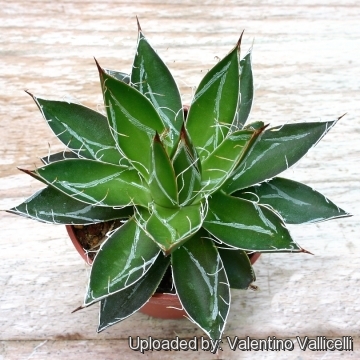 Agave filifera subs. schidigera f. compacta Photo by: Valentino Vallicelli
Agave filifera subs. schidigera f. compacta Photo by: Valentino Vallicelli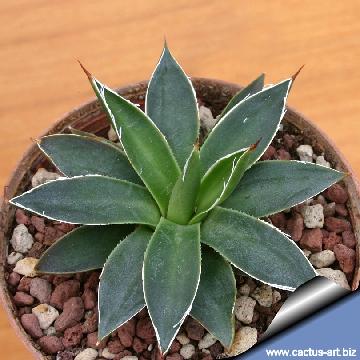 Agave filifera subs. schidigera f. compacta Photo by: Cactus Art
Agave filifera subs. schidigera f. compacta Photo by: Cactus Art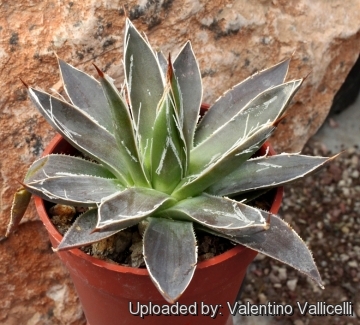 Agave filifera subs. schidigera f. compacta Photo by: Valentino Vallicelli
Agave filifera subs. schidigera f. compacta Photo by: Valentino Vallicelli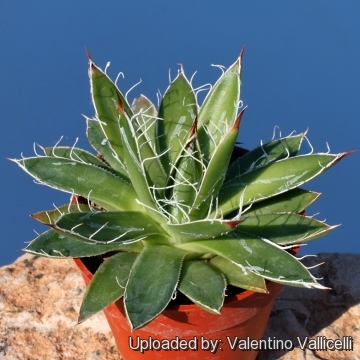 Agave filifera subs. schidigera f. compacta Photo by: Valentino Vallicelli
Agave filifera subs. schidigera f. compacta Photo by: Valentino VallicelliCultivation and Propagation: Good in containers. Agave schidigeraSN|556]]SN|556]] is a relatively easy-to-grow species tolerant of most soils. The only requirement is that it have good drainage and not be waterlogged. Plants have a moderate growth rate,
responding to some supplemental water during the growing season (spring through early fall). It is theoretically hardy to -7° C , particularly when dry. It is damaged from early morning overhead watering in the winter. The water froze resulting in pockmarks on the leaves. It grows fairly fast in summer if provided with copious water but allows to dry thoroughly before watering again. During the winter months, one should only water enough to keep the leaves from shrivelling. They do well in full sun or a lightly shaded area. Plants cultivated outdoors are drought tolerant and takes blasting heat and full sun. Benefit from fertilization in the spring and summer.
It is quite versatile. Because of its symmetrical form and relatively small size, this plant is very attractive when grown in pots. Plants can be grouped together or planted among boulders in a rock or cactus garden. They work well with perennials
Propagation: By suckers which often are found growing around the base of the plant, Remove the basal suckers (if available) in spring or summer and let the cuttings dry for a few days before inserting in compost or by seed.
More...














